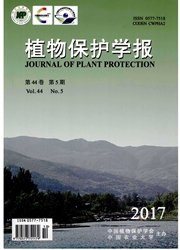

 中文摘要:
中文摘要:
为鉴定云南稻种质资源对水稻白叶枯病的抗性情况,于孕穗期采用剪叶接种方法,用水稻白叶枯病强致病型代表菌株BD8438、CN9404和X1接种云南野生稻和地方稻种质资源,以病斑长度大于6 cm为感病分界线,对其抗感表现型进行调查分析。结果显示,共鉴定出来源于云南省不同种植生态区的186份地方稻抗性材料和22个野生稻抗病居群。野生稻对水稻白叶枯病的抗病能力较地方稻强,其中疣粒野生稻的抗性最强,抗病等级为0~2;药用野生稻次之,抗病等级为1~2;普通野生稻相对较差,抗病等级为1~5。地方稻抗性资源来自于云南省各个传统水稻种植区,抗性1级的材料占17%,抗性2级的占2%,抗性3级的占81%;按照稻种质资源亚种类型、粘糯性和水旱性分类,各类型地方稻抗性材料所占比例分别为粳稻占61%、籼稻占39%;粘稻占66%、糯稻占34%;水稻占83%、陆稻占17%。从利用抗白叶枯病基因培育新品种的角度评价,这些抗性资源具有潜在的发掘利用价值。
 英文摘要:
英文摘要:
Bacterial blight,caused by Xanthomonas oryzae pv. oryzae( Xoo),is the most destructive bacterial disease of rice worldwide. In order to explore and utilize resistant cultivars to control bacterial blight,the wild rice species and local landraces of Oryza sativa L. were identified by using leaf cutting inoculation at booting stage in Yunnan,China. Three strong pathogenic strains BD8438,CN9404 and X1 of Xoo were used to screen wild rice and local landraces accessions collected from different areas of Yunnan.The susceptible boundary as the lesion length was greater than 6 cm. The results showed that 186 local landrace accessions and 22 wild rice native populations had different resistance abilities. The disease resistance of wild rice was stronger than the local landrace accessions. O. granulata had the strongest resistance( the grade of disease resistance was 0- 2),O. officinalis had the second resistance( the grade of disease resistance was 1- 2),O. rufipogon had the third resistance( the grade of disease resistance was1- 5). The local landrace rice resistant resources were collected from almost every traditional rice cultivation area in Yunnan,grade 1 accounted for 17%,grade 2 accounted for 2% and grade 3 accounted for 81%. These belonged to different types of O. sativa in terms of taxonomy-japonica rice and indica rice,or glutinous rice and non-glutinous rice,or upland rice and paddy rice. The japonica rice had more accessions( 61%) with bacterial blight resistance ability than indica rice( 39%),non-glutinous rice( 66%) than glutinous rice( 34%),paddy rice( 83%) than upland rice( 17%). These resistant resources had potential value to explore new varieties of resistance to bacterial blight.
 同期刊论文项目
同期刊论文项目
 同项目期刊论文
同项目期刊论文
 期刊信息
期刊信息
